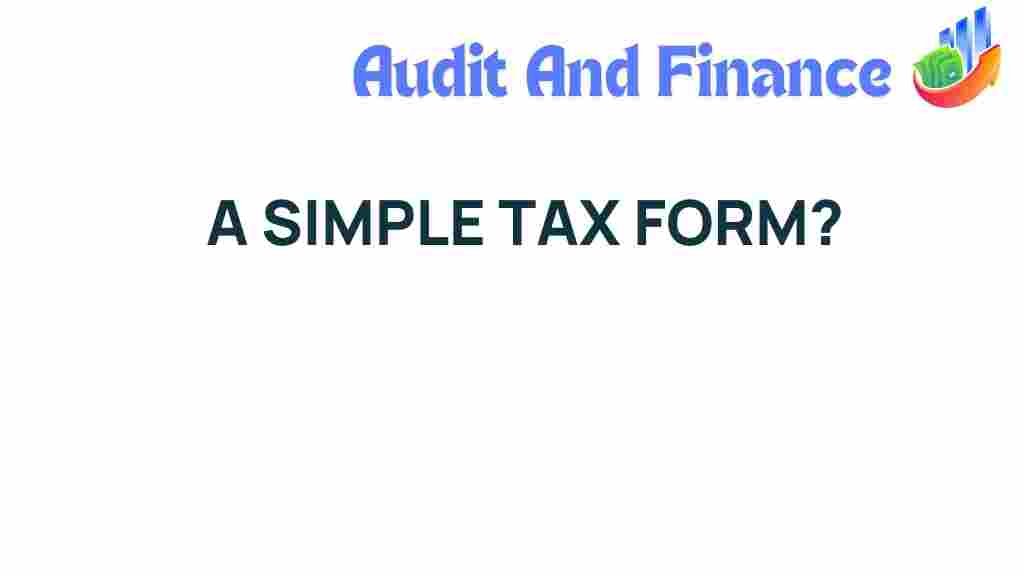The Hidden Complexities Behind a Simple Tax Form
When you think of a tax form, the first image that might come to mind is a simple sheet of paper with boxes to fill in. However, the reality is that behind this seemingly straightforward document lies a web of complexities shaped by IRS regulations, tax code intricacies, and individual circumstances. Understanding these complexities is crucial for both compliance and maximizing your potential deductions.
Understanding the Basics of Tax Forms
Tax forms are essential documents that taxpayers must complete to report their income, claim deductions, and fulfill their tax obligations. In the United States, the IRS provides various forms tailored to different types of income and expenses. Here’s a brief overview:
- Form 1040: The standard individual income tax return.
- Form W-2: Issued by employers to report wages paid and taxes withheld.
- Form 1099: Reports various types of income earned outside of employment.
- Schedule C: Used for reporting income from a business or profession.
The Illusion of Simplicity
At first glance, the structure of a tax form may appear simple, but it often conceals the complexities of financial literacy and compliance. Taxpayers may find themselves overwhelmed by the language used in the tax code, the nuances of each form, and the implications of their financial situation.
For example, a taxpayer with multiple income streams will need to navigate various forms and understand how to report each source accurately. The interplay of different forms can lead to confusion, and mistakes can result in penalties or missed deductions.
Step-by-Step Process of Filing Your Tax Form
Filing your tax form can be a daunting task, but following a structured approach can make it manageable. Here’s a step-by-step guide to help you through the process:
1. Gather Your Documents
Before you start filling out your tax form, collect all necessary documentation:
- W-2 forms from employers
- 1099 forms for freelance work or other income
- Receipts for potential deductions (e.g., medical expenses, charitable donations)
- Records of any taxable investments
2. Choose the Right Tax Form
Determine which tax form is appropriate for your situation. Most individuals will use Form 1040, but your circumstances might require additional schedules or forms.
3. Understand Deductions and Credits
Familiarize yourself with available deductions and credits that can reduce your tax liability. Common deductions include:
- Mortgage interest
- Student loan interest
- Medical expenses exceeding a certain percentage of your income
Tax credits, such as the Earned Income Tax Credit (EITC), can also significantly reduce your tax bill.
4. Fill Out the Form Accurately
As you begin to fill out your tax form, pay attention to detail. Ensure that all information is accurate and matches your documentation. Double-check numbers to avoid errors.
5. Review and File
After completing your tax form, review it thoroughly. Consider using tax preparation software or consulting with a tax professional to ensure compliance with the IRS regulations. Once satisfied, submit your form electronically or via mail.
Troubleshooting Common Issues
Even with careful preparation, taxpayers may encounter issues while filing their tax forms. Here are some common problems and how to address them:
1. Missing Documents
If you’re missing a W-2 or 1099, contact your employer or the financial institution that issued the form. You can also access some documents online through financial accounts.
2. Confusion Over Deductions
When unsure about which deductions you qualify for, consider consulting the IRS website for comprehensive guidelines. Tax professionals can also provide personalized advice.
3. Errors on Your Form
Should you discover an error after filing, you can file an amended return using Form 1040-X. This allows you to correct mistakes and claim any additional deductions you missed.
The Role of Financial Literacy in Tax Compliance
Financial literacy plays a crucial role in navigating the complexities of the tax code. Taxpayers who understand basic financial principles are better equipped to handle their tax forms and make informed decisions that affect their finances. Here are some key areas where financial literacy can assist:
- Understanding Tax Brackets: Knowing how tax brackets work can help taxpayers anticipate their liabilities and plan accordingly.
- Identifying Tax-Advantaged Accounts: Awareness of accounts like IRAs or HSAs can lead to significant tax savings.
- Future Planning: Financial literacy enables taxpayers to strategize for future tax years, optimizing income and deductions.
Conclusion
While a tax form may seem simple on the surface, the underlying complexities can be daunting for many taxpayers. By understanding the IRS requirements, familiarizing yourself with the tax code, and enhancing your financial literacy, you can navigate the filing process more effectively.
Always remember that the goal is not just compliance, but also to take full advantage of the deductions and credits available to you. By doing so, you can minimize your tax liability and contribute to your overall financial well-being. Whether you choose to file independently or seek help, being informed is the key to successfully managing your taxes.
For more resources on tax preparation and filing, visit the IRS official site or consult a tax professional to ensure you are making the most of your tax situation.
This article is in the category Taxation and created by AuditAndFinance Team
